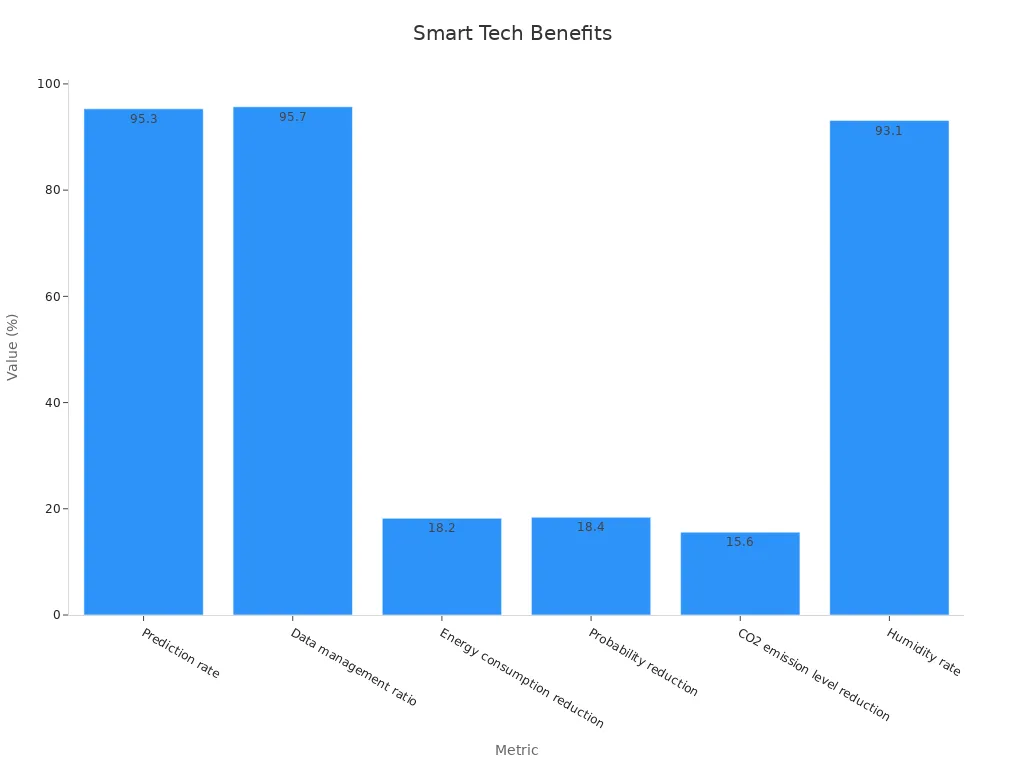ESTEL's telecom power system market innovations

The telecom power system market is evolving rapidly, and ESTEL stands at the forefront of this transformation. You can see this in their focus on energy efficiency, sustainability, and reliability. For example, 5G network expansion demands more efficient power systems, and ESTEL’s solutions meet these needs by reducing energy consumption. Their integration of smart grid technologies ensures optimized power distribution, keeping pace with high-speed communication demands. These innovations not only address industry challenges but also highlight ESTEL’s dedication to advancing modern telecom infrastructure.
Key Takeaways
ESTEL is a top company in telecom power systems. It creates new ideas to save energy and protect the environment.
Using hybrid power systems lowers costs and pollution. This makes telecom systems better for the planet.
Smart tools help manage power, using less energy and working better.
ESTEL's modern technology helps telecom systems handle the needs of 5G networks.
Adding renewable energy sources helps telecom companies stay green and work well.
Understanding the Telecom Power System Market
Current trends in the telecom power system market
The telecom power system market is undergoing significant changes, driven by technological advancements and evolving consumer demands. The global market is projected to grow from $3.4 billion in 2020 to approximately $6.94 billion by 2028, reflecting a compound annual growth rate (CAGR) of 9.6%. This growth stems from the increasing need for energy-efficient solutions, the expansion of telecom towers in rural areas, and the rising penetration of smartphones.
You can observe a shift toward hybrid and renewable-integrated power systems. These systems combine solar panels, battery storage, and diesel generators to ensure uninterrupted power supply, especially in off-grid locations. The reliance on renewable energy sources is reshaping the telecom power system market, aligning it with sustainability goals.
Other trends include the adoption of advanced technologies like artificial intelligence (AI) and the Internet of Things (IoT). These innovations enhance power management systems, enabling smart grids and energy storage solutions. As mobile broadband penetration and data center expansion continue, the demand for reliable and efficient telecom infrastructure grows.
Challenges shaping the telecom power system industry
Despite its promising growth, the telecom power system industry faces several challenges. High initial costs and installation expenses remain significant barriers for providers. Constructing and maintaining telecom towers and power system components adds complexity to the process.
Forecasts indicate that the market size will reach $7371.2 million by 2030, with a CAGR of 3.4% from 2024 to 2030. However, these projections highlight the need for innovative solutions to overcome existing hurdles. For example, the north america telecom power system market must address the challenges of scaling infrastructure while maintaining cost-effectiveness.
Another issue is the demand for uninterrupted power supply in remote areas. Hybrid systems help mitigate this challenge, but their implementation requires careful planning and investment. As the industry evolves, providers must balance operational efficiency with sustainability goals to meet growing consumer expectations.
Technological Advancements in the Telecom Power System Market

Energy efficiency and optimization
Energy efficiency plays a crucial role in the telecom power system market. As 5G networks expand, the demand for power-efficient solutions grows. You can see this in the shift from older systems to advanced technologies like 5G, which not only increases capacity but also reduces electricity consumption. A recent report highlights that while electricity use in the ICT sector is expected to grow, it will do so at a slower rate due to the adoption of energy-efficient technologies. This transition ensures that telecom infrastructure can handle increasing data demands without a proportional rise in energy consumption.
Innovative energy storage solutions are also transforming the telecom power system. For instance, integrating fuel cells with solar PV and battery systems has shown significant improvements in efficiency. Research demonstrates that hybridized systems reduce electricity system efficacy from 21.05% to 17.43%, lowering both costs and environmental impact. These advancements make it easier for you to achieve operational savings while supporting sustainability goals.
The north america telecom power system market is particularly focused on energy efficiency. Providers are adopting hybrid systems that combine renewable energy sources with traditional power solutions. This approach ensures uninterrupted power supply while minimizing energy waste. By prioritizing energy efficiency, you can reduce operational costs and enhance the reliability of your telecom infrastructure.
Renewable energy integration in telecom power systems
The integration of renewable energy sources is reshaping the telecom power system market. Hybrid power systems, which combine solar panels, battery storage, and diesel generators, are becoming increasingly popular. These systems ensure a reliable power supply, especially in off-grid areas, while significantly reducing carbon emissions. This shift aligns with the growing need for sustainable telecom infrastructure.
Statistical data confirms the effectiveness of renewable energy integration. The telecom power system market is projected to grow from USD 4.73 billion in 2025 to USD 9.09 billion by 2033, with a CAGR of 8.5%. This growth is driven by the adoption of renewable-integrated solutions, which lower operational costs and environmental impact. As telecom networks expand into remote regions, you can rely on these innovations to maintain efficiency and sustainability.
In the north america telecom power system market, renewable energy integration is a key focus. Providers are leveraging solar and wind energy to power telecom towers, reducing reliance on fossil fuels. This approach not only supports environmental goals but also ensures cost-effective operations. By adopting renewable energy solutions, you can contribute to a greener future while meeting the demands of modern telecom networks.
Smart monitoring and control technologies
Smart monitoring and control technologies are revolutionizing the telecom power system market. These innovations enable real-time tracking and management of power systems, ensuring optimal performance and reducing downtime. For example, IoT-based solutions allow you to monitor energy consumption, identify inefficiencies, and implement corrective measures promptly.
Studies and surveys highlight the benefits of smart monitoring technologies. For instance, these systems can reduce energy consumption by 18.2% and CO2 emissions by 15.6%. They also improve data management ratios and prediction rates, ensuring more accurate and efficient operations. The table below summarizes some of the key metrics:
Metric | Value |
|---|---|
Prediction rate | 95.3% |
Data management ratio | 95.7% |
Energy consumption reduction | 18.2% |
CO2 emission level reduction | 15.6% |

In the north america telecom power system market, smart monitoring technologies are essential for maintaining efficiency and reliability. These systems help you optimize power distribution, reduce operational costs, and enhance network uptime. By adopting smart monitoring solutions, you can ensure that your telecom infrastructure remains resilient and future-ready.
ESTEL's Contributions to the Telecom Power System Market
ESTEL's innovative technologies and solutions
ESTEL has consistently demonstrated its leadership in the telecom power system market by introducing cutting-edge technologies that address the industry's evolving needs. One of their standout innovations is the integration of advanced power technologies, which enhance energy efficiency and reduce operational costs. These technologies ensure that telecom infrastructure can handle increasing data demands while maintaining reliability.
For example, ESTEL's smart technology solutions optimize power distribution and improve system performance. Their systems are designed for easy maintenance, which minimizes downtime and enhances operational efficiency. The table below highlights some of the key performance indicators that showcase ESTEL's contributions:
Performance Indicator | Description |
|---|---|
Smart Technology | Utilizes advanced technology for improved performance. |
Maintenance Ease | Designed for easy maintenance, contributing to operational efficiency. |
ESTEL's focus on innovation extends to their energy-saving solutions. Their cabinet PDUs (Power Distribution Units) can save up to 20% energy, making them an eco-friendly choice for data centers. Additionally, their load-balancing capabilities prevent system overloads, ensuring uninterrupted operations. These advancements position ESTEL as a pioneer in next-generation power supply solutions.
Performance Indicator | Description |
|---|---|
Energy Savings | Cabinet PDUs can save up to 20% energy, making data centers more eco-friendly. |
Load Balancing | Prevents overloads, ensuring systems run longer without sudden stops. |
Product offerings tailored for telecom power systems
ESTEL offers a diverse range of products specifically designed to meet the demands of the telecom power system market. Their product portfolio includes hybrid power solutions, renewable energy-integrated systems, and advanced cooling technologies. These offerings cater to the unique requirements of telecom infrastructure, ensuring efficiency and sustainability.
One of their flagship products is the hybrid power system, which combines renewable energy sources like solar and wind with traditional power solutions. This approach not only reduces carbon emissions but also ensures a reliable power supply in remote areas. ESTEL's advanced cooling technologies further enhance system performance by maintaining optimal operating temperatures, even in challenging environments.
Case studies from around the globe highlight the effectiveness of ESTEL's products. In Thailand, Telenor-DTAC successfully upgraded their telecom infrastructure using ESTEL's VMS (Virtual Management System). This solution helped them overcome the limitations of their legacy system, enabling seamless digital transformation. Similarly, in Nigeria, ESTEL's multi-purpose recharge cards have simplified telecom services for users, enhancing convenience and accessibility.
Location | Case Study Description |
|---|---|
Thailand | Telenor-DTAC improved their digital transformation with Estel's VMS, overcoming limitations of their legacy system. |
Lebanon | Charitable vouchers are generated and redeemed using Estel's VMS, aiding displaced individuals like Mr. Yanis. |
Nigeria | Multi-purpose recharge cards allow users like Mr. Oluwole to utilize a single code for various services, enhancing convenience. |
Addressing market challenges with ESTEL's expertise
The telecom power system market faces numerous challenges, including high installation costs, the need for uninterrupted power supply, and the demand for sustainable solutions. ESTEL addresses these challenges with its expertise and innovative approach. Their modules achieve over 95% efficiency, which reduces energy consumption and operational costs. These modules are also designed to withstand adverse conditions, ensuring durability and reliability.
Reliability Statistic | Description |
|---|---|
Efficiency | ESTEL modules achieve over 95% efficiency, which saves energy and reduces costs. |
Durability | Modules are designed to last long even in adverse conditions, ensuring reliability. |
In the North America telecom power system market, ESTEL's hybrid power solutions have proven to be a game-changer. By combining renewable energy sources with traditional systems, they provide a cost-effective and sustainable alternative. Their smart monitoring technologies further enhance system reliability by enabling real-time tracking and management. These solutions help you overcome operational challenges while supporting environmental goals.
ESTEL's commitment to technological advancements ensures that you can rely on their products to meet the demands of modern telecom networks. Whether you're looking to optimize energy usage, enhance system reliability, or reduce environmental impact, ESTEL's expertise offers a comprehensive solution.
Benefits of ESTEL's Telecom Power System Innovations

Cost-effectiveness and operational savings
ESTEL’s telecom power system innovations deliver measurable cost savings and operational efficiency. By integrating advanced technologies like smart PDUs (Power Distribution Units), you can reduce energy consumption by up to 41%, as reported by the U.S. General Services Administration. These savings translate into millions of dollars annually, making ESTEL’s solutions a financially sound investment for telecom infrastructure.
A closer look at the benefits reveals how ESTEL optimizes business performance. Their systems streamline operations, automate tasks, and reduce fraud, safeguarding revenue. For example, real-time monitoring capabilities, as demonstrated by IBM, have led to 30% energy savings in data centers. This efficiency frees up resources, allowing you to focus on rapid network expansions and sustainable growth.
Benefit | Description |
|---|---|
Optimize Business Performance | Streamline operations, reduce costs, and boost revenue through data-driven decisions. |
Enhance Customer Experience | Tailor products and support to individual needs, improving subscriber satisfaction. |
Reduce Fraud & Revenue Leakage | Detect and prevent fraud, safeguarding against revenue loss using AI-driven capabilities. |
Increase Efficiency | Automate tasks, freeing up time and resources for your team. |
Reduce Churn | Increase loyalty, enhance customer satisfaction by personalizing support and resolving queries promptly. |
Enhanced reliability and network uptime
Reliability is critical for telecom power systems, especially with the growing demand for 5G services. ESTEL’s modular designs and AI integration ensure adaptability to evolving network needs. Their telecom rectifiers provide uninterrupted energy, supporting high-speed and low-latency communication systems. These innovations protect equipment from environmental damage, reducing system failures and downtime.
In 2023, over 1 billion people relied on 5G services, highlighting the importance of reliable telecom infrastructure. ESTEL’s systems are 90% more efficient per bit compared to 4G systems, ensuring steady connections for critical services like streaming and emergency calls. By adopting ESTEL’s solutions, you can maintain network uptime and meet the demands of rapid network expansions.
ESTEL telecom rectifiers offer unmatched efficiency and durability, crucial for reliable network operations.
Modular designs and AI integration ensure adaptability to growing network demands.
Telecom power systems ensure steady connections for critical services like streaming and emergency calls.
New systems utilize 20% less energy, enhancing operational efficiency.
Supporting sustainability and environmental goals
ESTEL’s commitment to sustainability is evident in their energy-efficient solutions. Their rectifiers achieve over 96% efficiency, reducing energy waste and cooling costs. By integrating seamlessly with renewable energy systems like solar panels and wind turbines, ESTEL helps you lower your carbon footprint while maintaining operational efficiency.
These innovations promote sustainable growth by reducing electricity bills and operational costs. For example, hybrid systems combining renewable sources with traditional power solutions ensure reliable energy supply while minimizing environmental impact. ESTEL’s focus on sustainability aligns with global efforts to combat climate change and achieve greener telecom infrastructure.
Metric/Initiative | Description |
|---|---|
Energy Efficiency | ESTEL rectifiers achieve energy efficiency exceeding 96%, reducing energy waste and cooling costs. |
Integration with Renewable Energy Systems | Seamless integration with solar panels and wind turbines, reducing carbon footprint. |
Operational Cost Reduction | High efficiency leads to lower energy consumption and electricity bills, promoting sustainability. |
By choosing ESTEL’s telecom power system innovations, you contribute to a sustainable future while ensuring cost-effective and reliable operations.
ESTEL has revolutionized the telecom power system market by delivering innovative solutions that enhance efficiency and sustainability. Their contributions ensure that modern networks remain reliable and adaptable to evolving demands. Continuous innovation drives progress, and ESTEL exemplifies this by integrating advanced technologies into telecom infrastructure. As you navigate the challenges of expanding networks, ESTEL's expertise offers a pathway to success. Explore their solutions to optimize your operations and build resilient networks that meet future demands.
FAQ
What makes ESTEL's telecom power systems unique?
ESTEL's systems combine energy efficiency, renewable energy integration, and smart monitoring technologies. These features ensure reliable performance, cost savings, and sustainability. Their modular designs adapt to evolving network demands, making them ideal for modern telecom infrastructure.
How does ESTEL support 5G infrastructure development?
ESTEL provides power solutions tailored for 5G networks. Their systems ensure uninterrupted energy supply, high efficiency, and low latency. These features support the growing demand for faster, more reliable communication services.
Can ESTEL's solutions reduce operational costs?
Yes, ESTEL's innovations, such as smart PDUs and hybrid power systems, significantly lower energy consumption. These solutions reduce electricity bills and maintenance costs, offering long-term operational savings.
Are ESTEL's products environmentally friendly?
ESTEL prioritizes sustainability by integrating renewable energy sources like solar and wind. Their high-efficiency rectifiers and hybrid systems minimize carbon emissions, aligning with global environmental goals.
How reliable are ESTEL's telecom power systems?
ESTEL's systems achieve over 95% efficiency and withstand harsh conditions. Their smart monitoring technologies ensure real-time tracking, reducing downtime and enhancing network reliability.
See Also
Understanding The ESTEL Power System For Telecom Cabinets
Essential Features Of Telecom Power Supply Systems Explained
Exploring The ESTEL Microgrid-Integrated Energy Storage Solution
Latest Innovations Shaping Outdoor Telecom Cabinet Designs
Strategies For Maintaining Reliable Power In Telecom Cabinets
CALL US DIRECTLY
86-13752765943
3A-8, SHUIWAN 1979 SQUARE (PHASE II), NO.111, TAIZI ROAD,SHUIWAN COMMUNITY, ZHAOSHANG STREET, NANSHAN DISTRICT, SHENZHEN, GUANGDONG, CHINA

